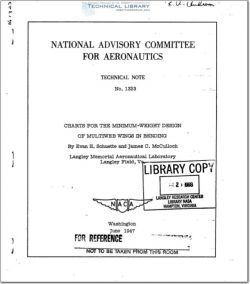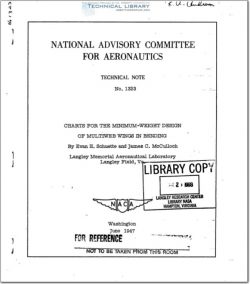NACA-TN-1323

- Version
- 465 Downloads
- 1.58 MB File Size
- 1 File Count
- July 14, 2016 Create Date
- July 14, 2016 Last Updated
National Advisory Committee for Aeronautics, Technical Notes - Charts for the Minimum Weight Design of Multiweb Wings in Bending

A method for the calculation of the buckling stress of a
multiweb wing in bending is presented, and design charts based
on this method are developed for‘the minimum- weight design of
multiweb wings of 2hS-T aluminum-alloy sheet, e: :truded 7534.13 alminum
alloy,and extruded O- =lHTA magnesium alloy. These charts make possible
the design of the lightest wings of this type for a wide range of
design requirements. An example of the use of the charts is given.
Because of the small absolute depth of thin high-speed wings,
some designers are considering the use of a type of construction
that employs a number of shear webs with no intermediate stiffening
of the skin (mutiweb wing) For a wing of this type, as for any
high-speed wing, the requirements of a smooth surface or a high
torsional stiffness result in the use of a fairly thick skin. If
the aspect ratio of the wing is relatively low, the compressive
stresses due to bending of the wing may be low and the problem of
buckling, therefore, a minor one. If the aspect ratio is relatively
high, however, the buckling of the smtcture due to bending may be
of primary significance, in spite of the relatively thick skin.
The present report considers a multiveb wing in which the
buckling oi' the webs and compression skin under bending loads is
of primary significance in the design. A method for calculating
the buckling stress is provided and design charts are presented
from which the proportions for minim weight can be chosen. An
example of the use of the design charts is given.
The methods by which the various charts were prepared are
discussed in appendixes A and B. Appendix C gives a discussion of
the effects of shear in the webs.
| File | Action |
|---|---|
| NACA-TN-1323 Charts for the Minimum Weight Design of Multiweb Wings in Bending.pdf | Download |

Comment On This Post